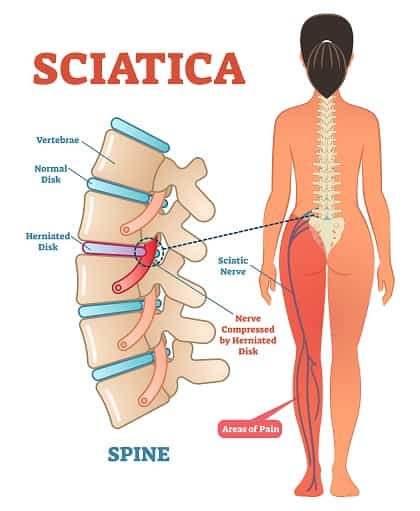Sciatica and Leg Pain

Overview
Sciatica essentially refers to any pain which can be felt in the leg (radiating from top to bottom). The large nerve running down at the back of the leg is called the sciatic nerve and is composed of numerous spinal nerves. Typically, spinal surgeons may refer to this kind of pain as radicular pain or radiculopathy instead of sciatica. This is because it is generally a spinal nerve which causes the pain instead of the sciatic nerve.
The lower back consist of 5 bones (vertebrae) and the disc (cushion) is found in the space between the bones. When the disc content (gel like) comes out of its place, it will press on the structures in front of it (nerves and spinal cord). The nerves come out of the lower back and go all the way down to the foot. When the sciatic nerve is injured or put under pressure, it can cause pain in the lower back that spreads all the way down the leg.
What causes sciatica?
Possible causes of Sciatica can be:
- Slipped disc – most common cause.
- Back injury or infection.
- Herniated disk.
- Spinal stenosis– narrowing of the spine where the nerves pass through.
- Spondylolisthesis– when one of the bones in your spine slips out of position.
What are the symptoms for sciatica?
Lower back pain that goes down to your hip and buttock and down the back of one leg. The pain may get worse when you sit, stand up, cough, or sneeze.
Your buttock, leg, foot and toes may also feel tingling, numb and painful. The symptoms of sciatica normally appear suddenly and will last for a few weeks.
You must see a doctor if your sciatica hasn’t improved after a few weeks, getting worse or stopping you from doing your daily activities.
How sciatica is diagnosed?
During the initial examination to determine if your sciatic nerve has been irritated, pinched or damaged, your doctor will need to know when and how the pain started and its exact location. The doctor may also ask to:
- Sit down.
- Stand up.
- Squat.
- Walk on your heels or toes.
- Raise your leg.
You may also need to have an MRI scan, CT scan or X-ray as these would show more details about the cause and location of the irritated nerve. Once the cause is determined, treatment can be prescribed by the doctor.
What are the treatments for sciatica?
- You may apply heated or ice packs for short periods of time (5-15 min) and see which type gives you more relief.
- Your doctor can suggest some exercises to help relief the pain and repair the damage.
- Taking painkillers such as aspirin or ibuprofen – for short-term pain relief.
- Physiotherapy – gently stretch the lower back and affected leg.
- Try to remain active by doing your normal daily activities – if possible.
- Short walks.
If the above initial treatments did not help, your doctor may prescribe the following:
- Steroid injection to help reduce the inflammation.
- Surgery would be an option if sciatica is caused by a herniated disk and you are still having severe pain after 5-6 weeks.

